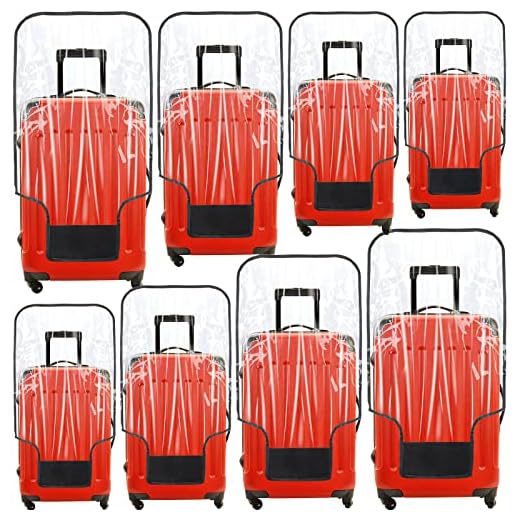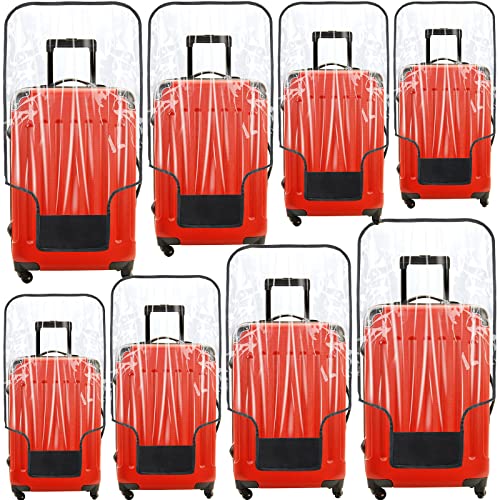


Using a high-quality protective cover can significantly minimize the risk of damage to your travel gear. Make sure to select a cover that fits snugly and is made of durable materials to withstand the rigors of travel.
Consider investing in corner protectors. These small accessories attach to the vulnerable areas of your suitcase, adding an extra layer of toughness against impacts and scuffs. They are often made of rubber or plastic and can be easily installed or removed.
Regularly applying a protective sealant on the exterior can also be beneficial. This treatment creates a barrier against scratches and enhances the finish of your gear. Be sure to choose a product specifically designed for the material of your bag, whether it’s hard-shell or soft fabric.
Lastly, utilizing packing cubes or organizers inside your suitcase not only maximizes space but also prevents contents from shifting and creating internal abrasion. This simple organizational method helps keep all items secure and minimizes the chance of wear and tear on the bag itself.
Methods to Shield Travel Bags from Marks
Employ a durable travel cover to envelop your bag, creating a barrier against potential impacts and abrasions during transit.
Choose materials with high scratch resistance. Polycarbonate and ballistic nylon offer excellent durability, minimizing damage from handling and rough surfaces.
Use corner protectors that can be attached to the edges. They’re designed to absorb shocks, maintaining the integrity of vulnerable areas.
Opt for structured designs that maintain rigidity. Soft-sided models may be prone to compression, increasing the likelihood of unsightly blemishes.
Consider using self-adhesive protective films to coat your bag, acting as an invisible shield against abrasions and scuffs.
| Method | Benefit |
|---|---|
| Travel Cover | Provides an external layer of defense |
| Durable Materials | Reduces likelihood of surface damage |
| Corner Protectors | Enhances protection at high-impact zones |
| Structured Design | Prevents compressive wear and tear |
| Protective Films | Maintains visual appeal with minimal visibility |
Regular cleaning can also help maintain appearance. Use a damp cloth to remove dust and prevent scratches that may form from debris.
Store your gear properly when not in use to avoid unnecessary contact with other items that may cause unwanted marks.
Selecting Scratch-Resistant Materials for Your Luggage
Opt for polycarbonate or ABS plastic for robust durability. These materials provide strong resistance against marks and dents.
Beyond plastics, ballistic nylon is another excellent choice, known for its toughness and ability to withstand abrasion. It’s particularly useful for soft-sided carriers.
Consider fabrics with special coatings. For instance, Teflon-treated surfaces can repel dirt and liquids while adding an additional layer of defense.
Material Comparison
- Polycarbonate: Lightweight, impact-resistant, provides effective shielding against impacts.
- ABS Plastic: Cost-effective, good balance of strength and weight, slightly less durable than polycarbonate.
- Ballistic Nylon: Exceptional tear-resistance, ideal for heavy-duty use, often used in travel backpacks.
- Teflon Coating: Water-resistant, adds a protective layer against everyday wear and stains.
Other Options to Consider
- Leather: While stylish, it can be prone to scuffs; choose treated leather for better resilience.
- Microfiber: Offers a sleek appearance and decent durability, often easier to clean than other materials.
Evaluate the intended use and travel frequency when choosing your bag’s materials. Prioritize scratch-resistant options to prolong the lifespan of your gear.
Using Protective Covers and Sleeves
Opt for specifically designed covers or sleeves that serve as reliable barriers against damage. These accessories, often made from durable materials, envelop your suitcase, shielding it from external contact and wear.
Choose a cover with a snug fit to ensure that it stays in place, reducing the chances of it slipping off during transit. Look for options featuring reinforced seams and tear-resistant fabrics, as these details enhance longevity and resistance to abrasion.
For added convenience, consider covers that are lightweight and easy to store. Many designs are foldable, making them practical for travel as well. Ensure the material is water-resistant as well, offering protection against moisture while preserving the integrity of the bag underneath.
Utilize padded sleeves for individual compartments, particularly for electronic devices or delicate items within your main case. These sleeves often come with adjustable straps or secure closures to keep everything in place, preventing movement that may cause scratches.
Regularly inspect the condition of both the cover and any sleeves used. Replace them if signs of wear appear, maintaining a barrier that can effectively guard against unsightly marks and blemishes.
Proper Packing Techniques to Minimize Damage
Utilize soft packing materials such as bubble wrap or clothing to cushion items inside the case. Wrap delicate belongings like electronics and glassware individually to prevent contact that can lead to marks.
Stack heavier items at the bottom and lighter ones on top to reduce pressure on more fragile objects. This arrangement minimizes the risk of impact during handling.
Employ compression bags for clothing to save space while preventing movement, thus decreasing potential friction or abrasions. Ensure nothing is loosely packed.
Fill empty spaces with smaller items, like socks or accessories, to create a snug fit. This technique decreases shifting and the chance of exterior contact that might lead to unsightly blemishes.
Consider utilizing dividers or packing cubes to keep belongings organized and separated. This not only adds efficiency but also further protects items from unintended contact.
For an extra layer of reassurance for particularly fragile pieces, apply a lightweight protective film. Additionally, you may find these tips useful if you are considering restoring chipped belongings, as seen in this article on how can a dentist fix a chipped tooth.
Regular Maintenance and Cleaning Tips for Travel Bags
To extend the lifespan of your travel gear, develop a routine that includes prompt cleaning after each trip. Use a damp cloth with mild soap to wipe down the exterior, removing dirt and stains that can lead to wear over time. For fabric materials, a soft brush may be useful to get rid of embedded dirt.
Storage Practices
Store bags in a cool, dry environment, away from direct sunlight. Consider using dust bags or boxes to shield against dust and potential scratches. Ensure zippers and buckles are not under pressure during storage to prevent deformation.
Hardware Inspection
Regularly check zippers, handles, and wheels for signs of damage. Tighten loose screws and lubricate moving parts as needed. Address any issues promptly to avoid further deterioration, ensuring all mechanisms function smoothly.
In addition, use resources like the best way to pack a hiking backpack for effective packing techniques, which minimize strain on your gear during travel.







